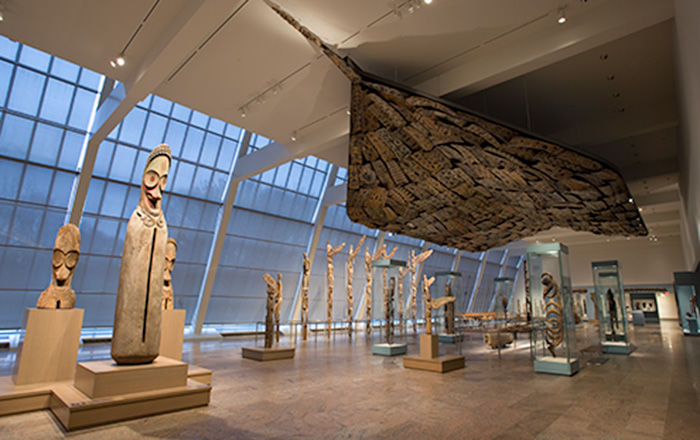Ornament Frontal
This small gold crab, originally the front part of an ear or nose ornament, was cut from a piece of hammered gold sheet and inlaid with green stones on the body, legs, and pleon. The crab probably was attached to a metal (likely silver) backing by small tabs, remnants of which can be seen on the outer extremes of the two bottom legs. On their ceramics, Moche artisans often depicted crabs with supernatural or anthropomorphic features, often engaged in combat (for other examples see MMA 67.167. 5 and Donnan and McClelland,1999: 162, fig. 5.40).
The Moche (also known as the Mochica) flourished on Peru’s North Coast from 200-850 CE, centuries before the rise of the Incas. Over the course of some seven centuries, the Moche built thriving regional centers from the Nepeña River Valley in the south to as far north as the Piura River, near the modern border with Ecuador, developing coastal deserts into rich farmlands and drawing upon the abundant maritime resources of the Pacific Ocean’s Humboldt Current. Although the precise nature of Moche political organization is unknown, these centers shared unifying cultural traits such as religious practices (Donnan, 2010).
This object was said to have been found at the site or sites known as Loma Negra, a northern outpost of Moche culture. Loma Negra works in metal share similar iconography with ceramics and metalwork found at Moche sites farther to the south, such as Ucupe (Bourget, 2014). The precise relationship between the Loma Negra and the Moche “heartland” remains a subject of debate, however (Kaulicke, 2006).
References and Further Reading
Bourget, Steve. Les rois mochica: Divinité et pouvoir dans le Pérou ancien. Paris: Somogy éditions d'art. Geneva: MEG, Musée d'ethnographie de Genève, 2014.
Castillo, Luis Jaime. “Masters of the Universe: Moche Artists and Their Patrons.” In Golden Kingdoms: Luxury Arts in the Ancient Americas, edited by Joanne Pillsbury, Timothy Potts, and Kim N. Richter, pp. 24-31. Los Angeles: J. Paul Getty Museum, 2017.
Donnan, Christopher B. “Moche State Religion.” In New Perspectives on Moche Political Organization, edited by Jeffrey Quilter and Luis Jaime Castillo, pp. 47-69. Washington D.C.: Dumbarton Oaks Research Library and Collection, 2010.
Donnan, Christopher B. and Donna McClelland. Moche Fineline Painting: Its Evolution and Its Artists. Los Angeles: Fowler Museum of Cultural History, University of California, 1999.
Kaulicke, Peter. “The Vicús-Mochica Relationship.” In Andean Archaeology III, edited by William H. Isbell and Helene H. Silverman, pp. 85-111. Boston: Springer, 2006.
This image cannot be enlarged, viewed at full screen, or downloaded.

